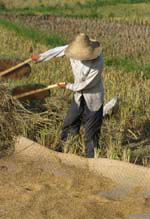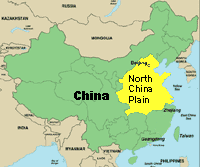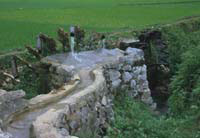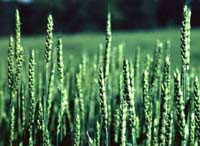If you aren’t normally fascinated by China’s agricultural problems, then an obscure report issued this summer on the state of the nation’s water supply might have struck you as rather dry. But in this case, dry is precisely the problem: The water table under the North China Plain, which produces over half of China’s wheat and a third of its corn, is falling at an alarming rate.

A Chinese farmer at work.
Photo: ArtToday.
The study, conducted by Beijing’s Geological Environmental Monitoring Institute (GEMI), reported that over-pumping has largely depleted the shallow aquifer, forcing well-drillers to resort to the region’s deep aquifer. That’s bad news, because the deep aquifer cannot be replenished. Under Heibei Province in the heart of the North China Plain, the average level of the deep aquifer dropped by almost 10 feet last year. Around some cities in the province, it fell by more than twice that.
He Qingcheng, head of the GEMI groundwater monitoring team, says that with the depletion of the deep aquifer under the North China Plain, the region is losing its last water reserve — drain that, and the safety net is gone.
His concerns are mirrored in a new World Bank report: “Anecdotal evidence suggests that deep wells [drilled] around Beijing now have to reach 1,000 meters [more than half a mile] to tap fresh water, adding dramatically to the cost of supply.” In unusually strong language for the normally restrained World Bank, the report forecasts “catastrophic consequences for future generations” unless water use and supply can be brought back into balance soon.
Dry Me a River
The frenzy of well-digging in recent years provides further evidence of the gravity of the water situation in the North China Plain. At the end of 1996, the five provinces of the North China Plain — Heibei, Henan, Shandong, and the city provinces of Beijing and Tianjin — had 3.6 million wells, the bulk of them for irrigation. The following year, 99,900 wells were abandoned as they ran dry. Some 221,900 new wells were drilled. The desperate quest for water in China continues today, as well-drillers chase the water table downward.

The North China Plain.
Map: U.S. State Department.
The bottom line is simple: The northern half of China is drying out. Excessive demands on the three rivers that flow eastward into the North China Plain — the Hai, the Yellow, and the Huai — are causing them to run out of water entirely during the dry season, sometimes for extended periods of time. The flow of the Yellow River into Shandong Province (the last of the eight provinces it passes through en route to the sea, and China’s leading grain-producing province) has dropped from 40 billion tons a year in the early 1980s to 25 billion tons during the 1990s.
As water tables fall, springs dry up, streams cease to flow, rivers run dry, and lakes disappear. Hebei Province once had 1,052 lakes. Only 83 remain.
The water deficit in the North China Plain (that is, the amount by which use exceeds sustainable supply) may now exceed 40 billion tons per year. At present that deficit is being filled by groundwater mining, but when aquifers are depleted and there is nothing more to mine, the basin’s water supply will be cut by nearly 40 percent. In the Hai River Basin, where industry and cities like Beijing and Tianjin now get priority for water use, irrigated agriculture could largely disappear by 2010, forcing a shift back to less productive rain-fed agriculture.

Irrigation projects like this are drying up.
Photo: ArtToday.
Between now and 2010, when China’s population is projected to grow by 126 million people, the World Bank predicts that the country’s urban water demand will jump from 50 billion to 80 billion tons, an increase of 60 percent. Industrial water demand, meanwhile, will increase 62 percent, from 127 billion to 206 billion tons.
With water worth easily 70 times as much in industry as in agriculture, farmers almost always lose out to cities in the competition for an ever-scarcer resource. As water tables continue to fall, rising pumping costs will make underground water too costly for many farmers to use for irrigation.
Against the Grain
Water scarcity is only one of many environmental and economic factors threatening China’s grain production. China has been striving tirelessly to maintain self-sufficient grain production since 1994. It has done so by raising support prices of grain well above the world market level, by over-plowing land on a scale that helped create the world’s largest dust bowl, and by over-pumping the aquifers under the North China Plain.
Weak prices, falling water tables, and severe drought together caused the grain harvest in 2001 to drop to 335 million tons, down from the all-time high of 392 million tons in 1998. This year’s harvest will fall short of projected consumption by 46 million tons, easily the biggest grain shortage in China’s history. This dramatic deficit, coming as it does on the heels of last year’s 34 million-ton shortfall, raises serious questions about future food security.
The combination of back-to-back shortages and China’s reluctance to import grain have caused the nation’s grain reserves to fall by roughly 81 million tons. With accessible grain stocks now largely depleted, another sizable crop shortfall in 2002 would almost certainly force China to import large amounts of grain to prevent soaring food prices.

Whither China’s wheat?
Photo: USDA.
China’s grain imports could climb quickly, as its recent experience with soybeans shows. When grain support prices were raised in 1994, resources were diverted from soybeans, the nation’s fourth-biggest crop after wheat, rice, and corn. As a result, the soybean harvest has fallen 6 percent since 1994, while demand has doubled. In an abrupt turnaround, China has gone from being a small net exporter of soybeans in 1993 to being the world’s largest importer in 2001, bringing in 14 million of the 30 million tons it consumes.
If China joins the World Trade Organization in late 2001, as expected, it must promise to import 7 million tons of wheat and 5 million tons of corn. But if the nation has another sizable grain harvest shortfall in 2002, it will likely be forced to import far more.
With its aquifers being depleted, China must consider its options for reestablishing a balance between water use and supply. Three possible initiatives stand out: diversion of water from the south to the north, water conservation, and grain imports. A south/north diversion to transport water from the Yangtze River Basin would cost tens of billions of dollars and displace hundreds of thousands of people. A comparable investment in more water-efficient industrial practices, more water-efficient household appliances, and, above all, more-efficient irrigation practices would likely yield more water. Since it takes 1,000 tons of water to produce one ton of grain, importing grain is the most efficient way to import water.
Regardless of whether it concentrates solely on conservation or also does a south/north diversion, China will almost certainly have to turn to the world market for grain imports. If it imports even 10 percent of its grain supply — 40 million tons — it will become the world’s largest grain importer overnight,
putting intense pressure on exportable grain supplies and driving up global prices. If this happens, we won’t need to read about it in the newspapers. We’ll learn the hard way, at the grocery store checkout counter.

